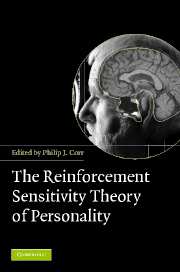Book contents
- Frontmatter
- Contents
- List of abbreviations
- List of figures
- List of tables
- List of contributors
- Preface
- 1 Reinforcement Sensitivity Theory (RST): introduction
- 2 The neuropsychology of fear and anxiety: a foundation for Reinforcement Sensitivity Theory
- 3 Animal cognition and human personality
- 4 The behavioural activation system: challenges and opportunities
- 5 Reinforcement Sensitivity Theory and personality
- 6 Reinforcement sensitivity scales
- 7 Performance and conditioning studies
- 8 Psychophysiological studies
- 9 Reinforcement Sensitivity Theory and mood induction studies
- 10 Neuro-imaging and genetics
- 11 Reinforcement Sensitivity Theory and psychosomatic medicine
- 12 RST and clinical disorders: anxiety and depression
- 13 RST and psychopathy: associations between psychopathy and the behavioral activation and inhibition systems
- 14 Behavioural activation and inhibition in social adjustment
- 15 Reinforcement sensitivity in the workplace: BIS/BAS in business
- 16 Formal and computational models of Reinforcement Sensitivity Theory
- 17 Reinforcement Sensitivity Theory: a critique from cognitive science
- 18 The contribution of Reinforcement Sensitivity Theory to personality theory
- General Index
- Index of Names
- References
9 - Reinforcement Sensitivity Theory and mood induction studies
Published online by Cambridge University Press: 31 January 2011
- Frontmatter
- Contents
- List of abbreviations
- List of figures
- List of tables
- List of contributors
- Preface
- 1 Reinforcement Sensitivity Theory (RST): introduction
- 2 The neuropsychology of fear and anxiety: a foundation for Reinforcement Sensitivity Theory
- 3 Animal cognition and human personality
- 4 The behavioural activation system: challenges and opportunities
- 5 Reinforcement Sensitivity Theory and personality
- 6 Reinforcement sensitivity scales
- 7 Performance and conditioning studies
- 8 Psychophysiological studies
- 9 Reinforcement Sensitivity Theory and mood induction studies
- 10 Neuro-imaging and genetics
- 11 Reinforcement Sensitivity Theory and psychosomatic medicine
- 12 RST and clinical disorders: anxiety and depression
- 13 RST and psychopathy: associations between psychopathy and the behavioral activation and inhibition systems
- 14 Behavioural activation and inhibition in social adjustment
- 15 Reinforcement sensitivity in the workplace: BIS/BAS in business
- 16 Formal and computational models of Reinforcement Sensitivity Theory
- 17 Reinforcement Sensitivity Theory: a critique from cognitive science
- 18 The contribution of Reinforcement Sensitivity Theory to personality theory
- General Index
- Index of Names
- References
Summary
In relation to affect, Gray's (1970) original version of the Reinforcement Sensitivity Theory (RST) suggests that positive emotion and negative emotion reflect independent activities of the Behavioural Approach System (BAS) and the Behavioural Inhibition System (BIS), respectively (Gray 1990). A recent revision of the RST (Corr 2001, 2004; Gray and McNaughton 2000) implies that the BAS will facilitate positive emotion and antagonize negative emotion, while the BIS will facilitate negative emotion and antagonize positive emotion. This chapter reviews the extent to which mood induction studies support the original and revised RST. Also covered are the limitations of these studies, and the implications of existing data for psychopathology. Suggestions for future research in this area are proposed.
Reinforcement sensitivity theory and mood states
In the initial RST (Gray 1970; see Corr, chapter 1), the BIS is hypothesized to be sensitive to signals of conditioned punishment, frustrative non-reward and novelty. It is involved in regulating aversive motivation, in that its activation will cause individuals to inhibit further responses to such cues. The BAS, by contrast, is sensitive to signals of conditioned reward and non-punishment. It is involved in regulating appetitive motivation as its activation increases goal directed responses. A third system, the Flight-Fight System, is hypothesized to regulate responses to unconditioned punishment and non-reward cues.
In the revised RST (Gray and McNaughton 2000), the BAS is linked to conditioned and unconditioned appetitive stimuli. Aversive stimuli that do not involve approach responses are mediated by a Fight-Flight-Freeze System.
- Type
- Chapter
- Information
- The Reinforcement Sensitivity Theory of Personality , pp. 291 - 316Publisher: Cambridge University PressPrint publication year: 2008
References
- 4
- Cited by



